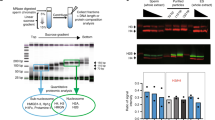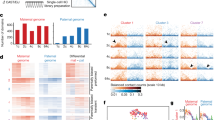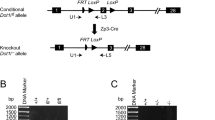Abstract
Because nucleosomes are widely replaced by protamine in mature human sperm, the epigenetic contributions of sperm chromatin to embryo development have been considered highly limited. Here we show that the retained nucleosomes are significantly enriched at loci of developmental importance, including imprinted gene clusters, microRNA clusters, HOX gene clusters, and the promoters of stand-alone developmental transcription and signalling factors. Notably, histone modifications localize to particular developmental loci. Dimethylated lysine 4 on histone H3 (H3K4me2) is enriched at certain developmental promoters, whereas large blocks of H3K4me3 localize to a subset of developmental promoters, regions in HOX clusters, certain noncoding RNAs, and generally to paternally expressed imprinted loci, but not paternally repressed loci. Notably, trimethylated H3K27 (H3K27me3) is significantly enriched at developmental promoters that are repressed in early embryos, including many bivalent (H3K4me3/H3K27me3) promoters in embryonic stem cells. Furthermore, developmental promoters are generally DNA hypomethylated in sperm, but acquire methylation during differentiation. Taken together, epigenetic marking in sperm is extensive, and correlated with developmental regulators.
This is a preview of subscription content, access via your institution
Access options
Subscribe to this journal
Receive 51 print issues and online access
$199.00 per year
only $3.90 per issue
Buy this article
- Purchase on Springer Link
- Instant access to full article PDF
Prices may be subject to local taxes which are calculated during checkout



Similar content being viewed by others
References
Ward, W. S. & Coffey, D. S. DNA packaging and organization in mammalian spermatozoa: comparison with somatic cells. Biol. Reprod. 44, 569–574 (1991)
Wykes, S. M. & Krawetz, S. A. The structural organization of sperm chromatin. J. Biol. Chem. 278, 29471–29477 (2003)
Balhorn, R., Brewer, L. & Corzett, M. DNA condensation by protamine and arginine-rich peptides: analysis of toroid stability using single DNA molecules. Mol. Reprod. Dev. 56, 230–234 (2000)
Gatewood, J. M., Cook, G. R., Balhorn, R., Schmid, C. W. & Bradbury, E. M. Isolation of four core histones from human sperm chromatin representing a minor subset of somatic histones. J. Biol. Chem. 265, 20662–20666 (1990)
Kimmins, S. & Sassone-Corsi, P. Chromatin remodelling and epigenetic features of germ cells. Nature 434, 583–589 (2005)
Nix, D. A., Courdy, S. J. & Boucher, K. M. Empirical methods for controlling false positives and estimating confidence in ChIP-Seq peaks. BMC Bioinformatics 9, 523 (2008)
Reik, W., Santos, F. & Dean, W. Mammalian epigenomics: reprogramming the genome for development and therapy. Theriogenology 59, 21–32 (2003)
Santos, F., Hendrich, B., Reik, W. & Dean, W. Dynamic reprogramming of DNA methylation in the early mouse embryo. Dev. Biol. 241, 172–182 (2002)
Rangasamy, D., Berven, L., Ridgway, P. & Tremethick, D. J. Pericentric heterochromatin becomes enriched with H2A.Z during early mammalian development. EMBO J. 22, 1599–1607 (2003)
Bernstein, B. E. et al. A bivalent chromatin structure marks key developmental genes in embryonic stem cells. Cell 125, 315–326 (2006)
Bernstein, B. E. et al. Methylation of histone H3 Lys 4 in coding regions of active genes. Proc. Natl Acad. Sci. USA 99, 8695–8700 (2002)
Boyer, L. A. et al. Core transcriptional regulatory circuitry in human embryonic stem cells. Cell 122, 947–956 (2005)
Muller, J. & Kassis, J. A. Polycomb response elements and targeting of Polycomb group proteins in Drosophila . Curr. Opin. Genet. Dev. 16, 476–484 (2006)
Schwartz, Y. B. et al. Genome-wide analysis of Polycomb targets in Drosophila melanogaster . Nature Genet. 38, 700–705 (2006)
Tanay, A., O’Donnell, A. H., Damelin, M. & Bestor, T. H. Hyperconserved CpG domains underlie Polycomb-binding sites. Proc. Natl Acad. Sci. USA 104, 5521–5526 (2007)
Cao, R. et al. Role of histone H3 lysine 27 methylation in Polycomb-group silencing. Science 298, 1039–1043 (2002)
Lee, T. I. et al. Control of developmental regulators by Polycomb in human embryonic stem cells. Cell 125, 301–313 (2006)
Takahashi, K. et al. Induction of pluripotent stem cells from adult human fibroblasts by defined factors. Cell 131, 861–872 (2007)
Kopp, J. L., Ormsbee, B. D., Desler, M. & Rizzino, A. Small increases in the level of Sox2 trigger the differentiation of mouse embryonic stem cells. Stem Cells 26, 903–911 (2008)
Wernig, M. et al. In vitro reprogramming of fibroblasts into a pluripotent ES-cell-like state. Nature 448, 318–324 (2007)
Mohn, F. et al. Lineage-specific polycomb targets and de novo DNA methylation define restriction and potential of neuronal progenitors. Mol. Cell 30, 755–766 (2008)
Illingworth, R. et al. A novel CpG island set identifies tissue-specific methylation at developmental gene loci. PLoS Biol. 6, e22 (2008)
Down, T. A. et al. A Bayesian deconvolution strategy for immunoprecipitation-based DNA methylome analysis. Nature Biotechnol. 26, 779–785 (2008)
Farthing, C. R. et al. Global mapping of DNA methylation in mouse promoters reveals epigenetic reprogramming of pluripotency genes. PLoS Genet. 4, e1000116 (2008)
Landgraf, P. et al. A mammalian microRNA expression atlas based on small RNA library sequencing. Cell 129, 1401–1414 (2007)
Glazov, E. A., McWilliam, S., Barris, W. C. & Dalrymple, B. P. Origin, evolution, and biological role of miRNA cluster in DLK-DIO3 genomic region in placental mammals. Mol. Biol. Evol. 25, 939–948 (2008)
Takada, S. et al. Delta-like and Gtl2 are reciprocally expressed, differentially methylated linked imprinted genes on mouse chromosome 12. Curr. Biol. 10, 1135–1138 (2000)
da Rocha, S. T., Edwards, C. A., Ito, M., Ogata, T. & Ferguson-Smith, A. C. Genomic imprinting at the mammalian Dlk1-Dio3 domain. Trends Genet. 24, 306–316 (2008)
Li, S. S., Liu, Y. H., Tseng, C. N. & Singh, S. Analysis of gene expression in single human oocytes and preimplantation embryos. Biochem. Biophys. Res. Commun. 340, 48–53 (2006)
Weber, M. et al. Distribution, silencing potential and evolutionary impact of promoter DNA methylation in the human genome. Nature Genet. 39, 457–466 (2007)
Fouse, S. D. et al. Promoter CpG methylation contributes to ES cell gene regulation in parallel with Oct4/Nanog, PcG complex, and histone H3 K4/K27 trimethylation. Cell Stem Cell 2, 160–169 (2008)
Vire, E. et al. The Polycomb group protein EZH2 directly controls DNA methylation. Nature 439, 871–874 (2006)
Schlesinger, Y. et al. Polycomb-mediated methylation on Lys27 of histone H3 pre-marks genes for de novo methylation in cancer. Nature Genet. 39, 232–236 (2007)
Ooi, S. K. et al. DNMT3L connects unmethylated lysine 4 of histone H3 to de novo methylation of DNA. Nature 448, 714–717 (2007)
Gordon, M. et al. Genome-wide dynamics of SAPHIRE, an essential complex for gene activation and chromatin boundaries. Mol. Cell. Biol. 27, 4058–4069 (2007)
Zalenskaya, I. A., Bradbury, E. M. & Zalensky, A. O. Chromatin structure of telomere domain in human sperm. Biochem. Biophys. Res. Commun. 279, 213–218 (2000)
Bolstad, B. M., Irizarry, R. A., Astrand, M. & Speed, T. P. A comparison of normalization methods for high density oligonucleotide array data based on variance and bias. Bioinformatics 19, 185–193 (2003)
Dudoit, S., Gilbert, H. N. & van der Laan, M. J. Resampling-based empirical Bayes multiple testing procedures for controlling generalized tail probability and expected value error rates: focus on the false discovery rate and simulation study. Biom. J. 50, 716–744 (2008)
Storey, J. D. & Tibshirani, R. Statistical significance for genomewide studies. Proc. Natl Acad. Sci. USA 100, 9440–9445 (2003)
Acknowledgements
We thank B. Dalley for microarray and sequencing expertise, B. Schackmann for oligonucleotides, K. Boucher for statistical analysis, J. Wittmeyer for yeast nucleosomes and helpful comments, and T. Parnell for helpful comments. Financial support was from the Department of Urology (genomics and support of S.S.H.), the Howard Hughes Medical Institute (HHMI) (genomics, biologicals and support of J.P. and H.Z.), CA24014 and CA16056 for core facilities, and the Huntsman Cancer Institute (bioinformatics and support of D.A.N.). B.R.C. is an investigator with the HHMI.
Author Contributions B.R.C., D.T.C. and S.S.H. were involved in the overall design. D.T.C. and S.S.H. were responsible for acquisition of samples, clinical logistics, patient consenting and Institutional Review Board documents. B.R.C., S.S.H., D.A.N. and H.Z. designed detailed molecular and genomics approaches. D.A.N. carried out data processing and array analysis. S.S.H. and D.A.N. performed sequencing analysis. S.S.H. carried out experiments and produced the figures. J.P. carried out immunoblotting and bisulphite sequencing. B.R.C. wrote the manuscript.
Author information
Authors and Affiliations
Corresponding authors
Supplementary information
Supplementary Figures
This file contains Supplementary Figures 1-12 with Legends. (PDF 1294 kb)
Supplementary Tables
This file contains Supplementary Tables 1-14. (PDF 1358 kb)
Supplementary Data
This file contains gene lists. (XLS 812 kb)
Rights and permissions
About this article
Cite this article
Hammoud, S., Nix, D., Zhang, H. et al. Distinctive chromatin in human sperm packages genes for embryo development. Nature 460, 473–478 (2009). https://doi.org/10.1038/nature08162
Received:
Accepted:
Published:
Issue Date:
DOI: https://doi.org/10.1038/nature08162
This article is cited by
-
Epigenetic markers in the embryonal germ cell development and spermatogenesis
Basic and Clinical Andrology (2023)
-
Distinct chromatin signatures in the Arabidopsis male gametophyte
Nature Genetics (2023)
-
Regulation, functions and transmission of bivalent chromatin during mammalian development
Nature Reviews Molecular Cell Biology (2023)
-
Sperm chromatin structure and reproductive fitness are altered by substitution of a single amino acid in mouse protamine 1
Nature Structural & Molecular Biology (2023)
-
Chromatin alterations during the epididymal maturation of mouse sperm refine the paternally inherited epigenome
Epigenetics & Chromatin (2022)
Comments
By submitting a comment you agree to abide by our Terms and Community Guidelines. If you find something abusive or that does not comply with our terms or guidelines please flag it as inappropriate.



